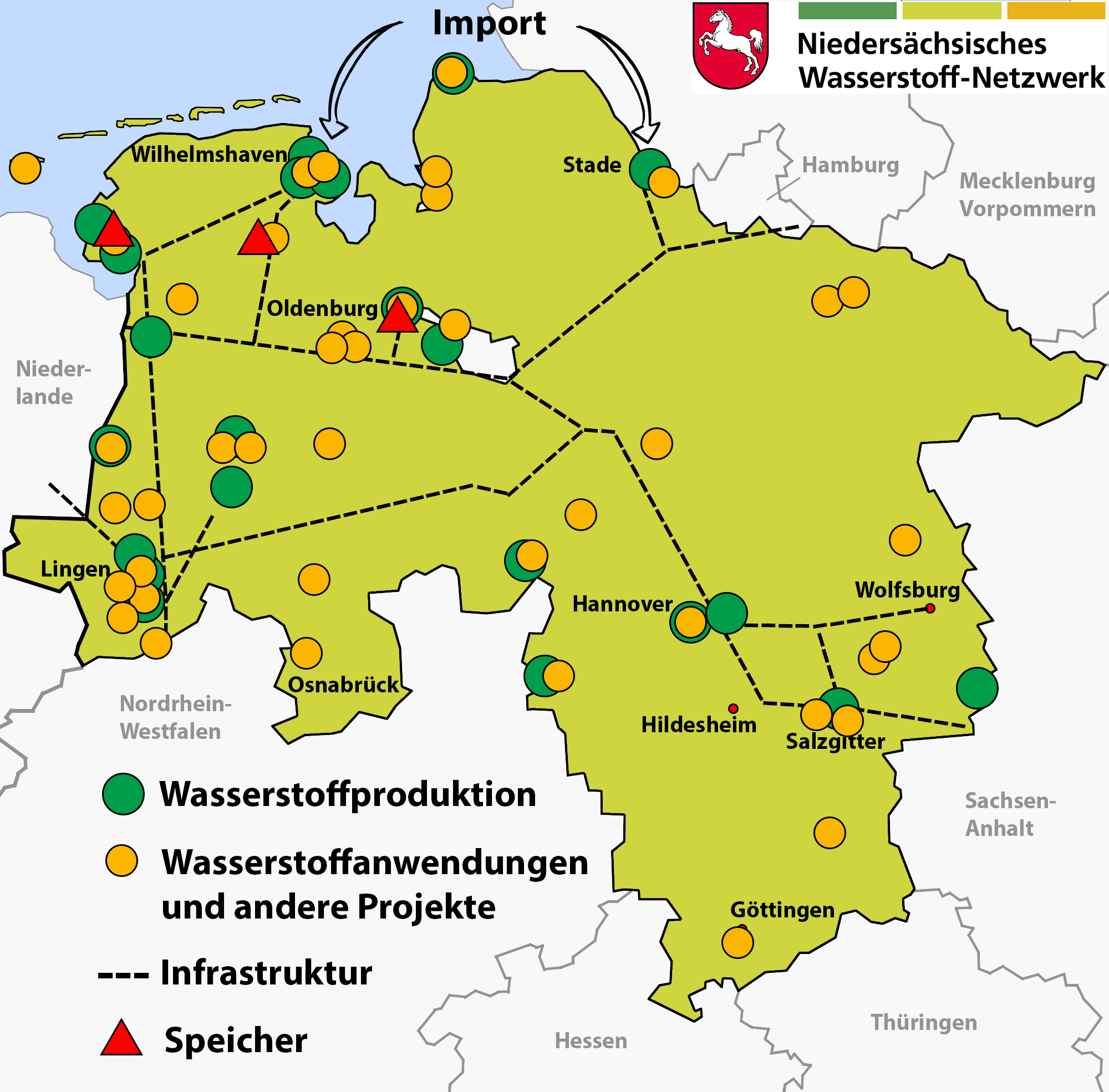Pressemitteilung
Niedersachsen stellt Weichen für die Finanzierung von Wasserstoff-Großprojekten
Das Kabinett hat am Dienstag, den 30. August 2022, die Finanzierung für Erzeugung und Import von Wasserstoff auf den Weg gebracht und damit die Weichen für die künftige Energieversorgung gestellt. Im Zuge des europäischen IPCEI-Programms für Wasserstofftechnologien und -systeme soll in Niedersachsen eine nachhaltige grüne Wasserstoffwirtschaft aufgebaut werden.
Die Bundesregierung fördert mit einer Ko-Finanzierung der Bundesländer große, grenzüberschreitende Vorhaben im Bereich Wasserstofftechnologien und -systeme unter anderem über IPCEI „Important Projects of Common European Interest“ („Wichtige Vorhaben von gemeinsamem europäischem Interesse“) und nach der Beihilfeleitlinie für Klima, Umwelt und Energie (KUEBLL).
Anfang 2021 konnten Unternehmen in einem Interessenbekundungsverfahren Projektskizzen für Investitionsvorhaben einreichen. Mittlerweile wurden auf EU-Ebene über 400 Projekte aus 18 Staaten registriert und werden von der EU-Kommission in verschiedenen „Wellen“ notifiziert, das heißt beihilferechtlich geprüft und genehmigt.
Am 28. Mai 2021 wurden vom Bund in Absprache mit den Ländern 62 deutsche Großvorhaben ausgewählt. Die Vorhaben sollen mit über acht Milliarden Euro an Bundes- und Landesmitteln gefördert werden.
Niedersachsen profitiert weit überdurchschnittlich von dem Förderprogramm. Die Lage an der Küste mit den Seehäfen, ein gut ausgebautes Gasnetz, große Kavernenspeicher und die enormen Potenziale an erneuerbaren Energien prädestinieren Niedersachsen als Erzeugungszentrum, Import-Hub und Drehscheibe der deutschen und europäischen Wasserstoffwirtschaft.
Sofern auf den heutigen Kabinettsbeschluss ein entsprechender Landtagsbeschluss im September-Plenum folgt, würden über 2,3 Milliarden Euro an staatlichen Fördermitteln für niedersächsische Investitionen in Wasserstoffprojekte mobilisiert: Der Bund bietet über 1,6 Milliarden Euro an, wenn sich das Land mit weiteren rund 700 Millionen Euro beteiligt.
Zur Finanzierung sieht der heute durch das Kabinett auf den Weg gebrachte Gesetzesentwurf eine weitere Aufstockung des Wirtschaftsförderfonds vor. Bereits am 29. Juni 2022 hatte der niedersächsische Landtag beschlossen, dem Wirtschaftsförderfonds 459,5 Millionen Euro, die aufgrund des günstigen Verlaufs des Haushaltsjahres 2021 zur Verfügung standen, für diesen Zweck zuzuführen. Nun sollen dem Wirtschaftsförderfonds in den Jahren 2024 bis 2026 weitere Mittel in Höhe von insgesamt 240 Millionen Euro für Wasserstoffprojekte zufließen. Der heute beschlossene Gesetzentwurf soll – wenn möglich – noch im September-Plenum verabschiedet werden.
„Mit einem Landesanteil von 700 Millionen Euro schaffen wir die Voraussetzungen zur Kofinanzierung von zwölf großen, grenzüberschreitenden Vorhaben im Bereich Wasserstofftechnologien und -systeme. Insgesamt geht es um Investitionen in Milliardenhöhe, einschließlich Bundesmitteln in Höhe von über 1,6 Milliarden Euro für niedersächsische Industrieunternehmen“, sagt Ministerpräsident Stephan Weil. „Grüner Wasserstoff wird eine wesentliche Säule unserer zukünftigen Energieversorgung sein. Niedersachsen ist in dieser Hinsicht führend. Das ist auch ein Beitrag dazu, Energieland Nr.1 zu werden.“
Wirtschaftsminister Bernd Althusmann sagt: „Zusätzlich zur Sicherung vorhandener Arbeitsplätze durch die Dekarbonisierung der CO2-intensiven Industrien von heute stellen diese Projekte eine sehr große Chance für die industrielle Weiterentwicklung Niedersachsens dar. Erneuerbare, günstige und sicher verfügbare Energie ist ein entscheidender Standortvorteil für neue Industrieansiedlungen in Niedersachsen.“
„Mit einer starken Wasserstoffwirtschaft tragen wir Niedersachsen unseren Teil zur Energiesicherheit und für die Unabhängigkeit Deutschlands bei. Sie ist ein wichtiger Teil des Fundaments für das Gelingen unserer klimapolitischen Ziele. Dabei muss die Erzeugung von grünem Wasserstoff, Transport, Speicherung und schließlich die großtechnische Anwendung räumlich und infrastrukturell zusammengedacht und -geführt werden. Nur so kann es gelingen, den Aufbau von Elektrolysekapazität im industriellen Maßstab zu realisieren und die Kosten für die Erzeugung und Nutzung von Wasserstoff zu senken“, sagt Energieminister Olaf Lies.
„Bereits mit der Mittelfristigen Planung 2022 bis 2026 haben wir insgesamt 750 Millionen Euro für eine ‚Investitionsoffensive Niedersachsen‘ vorgesehen, woraus jetzt die Gegenfinanzierung der Förderung der Wasserstofftechnologie erfolgt. Das ist gut angelegtes Geld, zumal wir damit ein Gesamtvolumen von über drei Milliarden Euro mobilisieren. Ein erneuter Beleg, dass mit einer vorausschauenden Finanzpolitik die schwarze Null und dreistellige Millionenbeträge für Zukunftstechnologien kein Widerspruch sind“, sagt Finanzminister Reinhold Hilbers.
Quelle: Niedersächsische Staatskanzlei
Hintergrund zum IPCEI Wasserstoff
Die Abkürzung „IPCEI“ steht für „Important Projects of Common European Interest (IPCEI)“ (deutsch: „Wichtige Vorhaben von gemeinsamem europäischen Interesse“). Mit einem IPCEI-Programm für Wasserstofftechnologien und -systeme soll der Aufbau einer nachhaltigen grünen Wasserstoffwirtschaft durch eine Investitionsförderung für wertschöpfungskettenübergreifende Wasserstoffprojekte im industriellen Maßstab angeschoben werden – national wie europaweit.
Anfang 2021 konnten Unternehmen in einem Interessenbekundungsverfahren Projektskizzen für Investitionsvorhaben einreichen. Mittlerweile wurden auf EU-Ebene über 400 Projekte aus 18 Staaten registriert und werden von der EU-Kommission notifiziert, das heißt beihilferechtlich geprüft und genehmigt. Am 28. Mai 2021 wurden vom Bund in Absprache mit den Ländern 62 deutsche Großvorhaben ausgewählt. Die Vorhaben sollen mit über acht Milliarden Euro an Bundes- und Landesmitteln gefördert werden.
Niedersachsen profitiert weit überdurchschnittlich hiervon – mit dem heutigen Kabinettsbeschluss können – ein entsprechender Landtagsbeschluss im Septemberplenum vorausgesetzt – über 2,3 Milliarden Euro an staatlichen Fördermitteln für Investitionen in Niedersachsen mobilisiert werden: Der Bund bietet rund 1,6 Milliarden Euro an, wenn sich das Land mit weiteren 700 Millionen Euro beteiligt.
Damit würden privatwirtschaftliche Investitionen der Industrie und Energiewirtschaft in Höhe von mehreren Milliarden Euro am Standort Niedersachsen ermöglicht.
Was soll damit erreicht werden?
- Aufbau von rund 850 MW Elektrolyseleitung in Niedersachsen in den nächsten 5 Jahren gefördert werden – d.h. rund 40% der bundesweit über dieses Förderprogramm finanzierten Elektrolyseleistung soll in Niedersachsen errichtet werden!
- Das Bundeswirtschaftsministerium rechnet mit den aktuellen Projekt mit insgesamt über 2 GW bundesweit. Zum Vergleich: Das Ziel in der Nationalen Wasserstoffstrategie beläuft sich auf 10 GW Elektrolyseleistung bundesweit bis 2030.
- Darüber hinaus: Schaffung von mehr als 500 km Wasserstofftransport-infrastruktur in Niedersachsen, größtenteils durch Umwidmung bestehender Erdgasleitungen aber auch durch Neubau von Wasserstoffpipelines sowie die Umrüstung von Kavernen für die Erdgasspeicherung zu
- Einstieg in die Transformation der Industrie hin zur Klimaneutralität durch Einsatz von grünem Wasserstoff, z.B. in der Stahlerzeugung und in Raffinerieprozessen
 Quelle: NWN
Quelle: NWN
©NWN
Bleiben Sie informiert – mit unserem Newsletter „NWN direkt…“
Sie möchten über diese und andere spannende Wasserstoff-Projekte aus Niedersachsen informiert bleiben? Dann melden Sie sich bei unserem Newsletter an!
